Assessing the Influences of Land Use Change on Groundwater Hydrochemistry in an Oasis-Desert Region of Central Asia
Abstract
:1. Introduction
2. Materials and Methods
2.1. Study Area
2.2. Data Collection and Analysis
3. Results
3.1. Variations of Land Use and Land Cover
3.2. Stable Water Isotopic Composition
3.3. Dissolved Ions
4. Discussion
4.1. SPATIO-Temporal Variations of Groundwater Hydrochemistry
4.2. Impacts of Land Use Change on Groundwater Hydrochemistry
4.3. Implications for Sustainable Groundwater Management
5. Conclusions
Author Contributions
Funding
Institutional Review Board Statement
Informed Consent Statement
Data Availability Statement
Acknowledgments
Conflicts of Interest
References
- Jasechko, S.; Seybold, H.; Perrone, D.; Fan, Y.; Kirchner, J.W. Widespread potential loss of streamflow into underlying aquifers across the USA. Nature 2021, 591, 391–395. [Google Scholar] [CrossRef]
- Zhao, M.; Geruo, A.; Zhang, J.; Velicogna, I.; Liang, C.; Li, Z. Ecological restoration impact on total terrestrial water storage. Nat. Sustain. 2021, 4, 56–62. [Google Scholar] [CrossRef]
- Yin, X.; Feng, Q.; Zheng, X.; Wu, X.; Zhu, M.; Sun, F.; Li, Y. Assessing the impacts of irrigated agriculture on hydrological regimes in an oasis-desert system. J. Hydrol. 2021, 594, 125976. [Google Scholar] [CrossRef]
- Gabiri, G.; Diekkrüger, B.; Leemhuis, C.; Burghof, S.; Naschen, K.; Asiimwe, I.; Bamutaze, Y. Determining hydrological regimes in an agriculturally used tropical inland valley wetland in central Uganda using soil moisture, groundwater, and digital elevation data. Hydrol. Process. 2018, 32, 349–362. [Google Scholar] [CrossRef]
- Chen, Y.; Hao, X.; Chen, Y.; Zhu, C. Study on water system connectivity and ecological protection countermeasures of Tarim River Basin in Xinjiang. Bull. Chin. Acad. Sci. 2019, 34, 1156–1164. (In Chinese) [Google Scholar]
- Erler, A.R.; Frey, S.K.; Khader, O.; D’Orgeville, M.; Park, Y.; Hwang, H.; Lapen, D.R.; Peltier, W.R.; Sudicky, E.A. Evaluating Climate Change Impacts on Soil Moisture and Groundwater Resources Within a Lake-Affected Region. Water Resour. Res. 2019, 55, 8142–8163. [Google Scholar] [CrossRef]
- Asoka, A.; Gleeson, T.; Wada, Y.; Mishra, V. Relative contribution of monsoon precipitation and pumping to changes in groundwater storage in India. Nat. Geosci. 2017, 10, 109–117. [Google Scholar] [CrossRef] [Green Version]
- Veldkamp, T.; Wada, Y.; Aerts, J.; Doll, P.; Gosling, S.; Liu, J.; Masaki, Y.; Oki, T.; Ostberg, S.; Pokhrel, Y.; et al. Water scarcity hotspots travel downstream due to human interventions in the 20th and 21st century. Nat. Commun. 2017, 8, 15697. [Google Scholar] [CrossRef]
- Kulmatov, R.; Mirzaev, J.; Abuduwaili, J.; Karimov, B. Challenges for the sustainable use of water and land resources under a changing climate and increasing salinization in the Jizzakh irrigation zone of Uzbekistan. J. Arid Land 2020, 12, 90–103. [Google Scholar] [CrossRef] [Green Version]
- Lapworth, D.; Krishan, G.; MacDonald, A.; Rao, M. Groundwater quality in the alluvial aquifer system of northwest India: New evidence of the extent of anthropogenic and geogenic contamination. Sci. Total Environ. 2017, 599–600, 1433–1444. [Google Scholar] [CrossRef] [Green Version]
- Krishan, G.; Rao, M.S.; Vashisht, R.; Chaudhary, A.; Singh, J.; Kumar, A. Isotopic Assessment of Groundwater Salinity: A Case Study of the Southwest (SW) Region of Punjab, India. Water 2022, 14, 133. [Google Scholar] [CrossRef]
- De Graaf, I.E.M.; Gleeson, T.; Van Beek, L.P.H.; Sutanudjaja, E.H.; Bierkens, M.F.P. Environmental flow limits to global groundwater pumping. Nature 2019, 574, 90–94. [Google Scholar] [CrossRef]
- Jia, H.; Qian, H.; Zheng, L.; Feng, W.; Wang, H.; Gao, Y. Alterations to groundwater chemistry due to modern water transfer for irrigation over decades. Sci. Total Environ. 2020, 717, 137170. [Google Scholar] [CrossRef]
- Wang, D.; Zhao, C.; Zheng, J.; Zhu, J.; Gui, Z.; Yu, Z. Evolution of soil salinity and the critical ratio of drainage to irrigation (CRDI) in the Weigan Oasis in the Tarim Basin. Catena 2021, 201, 105210. [Google Scholar] [CrossRef]
- Cai, Z.; Wang, W.; Zhao, M.; Ma, Z.; Lu, C.; Li, Y. Interaction between Surface Water and Groundwater in Yinchuan Plain. Water 2020, 12, 2635. [Google Scholar] [CrossRef]
- Wang, W.; Chen, Y.; Wang, W.; Xia, Z.; Li, X.; Kayumba, P.M. Hydrochemical characteristics and evolution of groundwater in the dried-up river oasis of the Tarim Basin, Central Asia. J. Arid Land 2021, 13, 977–994. [Google Scholar] [CrossRef]
- Lapworth, D.; Dochartaigh, B.; Nair, T.; O’Keeffe, J.; Krishan, G.; MacDonald, A.; Khan, M.; Kelkar, N.; Choudhary, S.; Krishnaswamy, J.; et al. Characterising groundwater-surface water connectivity in the lower Gandak catchment, a barrage regulated biodiversity hotspot in the mid-Gangetic basin. J. Hydrol. 2021, 594, 125923. [Google Scholar] [CrossRef]
- Zhang, Z.; Hu, H.; Tian, F.; Yao, X.; Sivapalan, M. Groundwater dynamics under water-saving irrigation and implications for sustainable water management in an oasis: Tarim River basin of western China. Hydrol. Earth Syst. Sci. 2014, 18, 3951–3967. [Google Scholar] [CrossRef] [Green Version]
- Wang, W.; Chen, Y.; Wang, W.; Jiang, J.; Cai, M.; Xu, Y. Evolution characteristics of groundwater and its response to climate and land-cover changes in the oasis of dried-up river in Tarim Basin. J. Hydrol. 2021, 594, 125644. [Google Scholar] [CrossRef]
- Wang, W.; Chen, Y.; Wang, W. Groundwater recharge in the oasis-desert areas of northern Tarim Basin, northwest China. Hydrol. Res. 2020, 51, 1506–1520. [Google Scholar] [CrossRef]
- Wang, P.; Yu, J.; Zhang, Y.; Liu, C. Groundwater recharge and hydrogeochemical evolution in the Ejina Basin, northwest China. J. Hydrol. 2013, 476, 72–86. [Google Scholar] [CrossRef]
- Pant, R.R.; Zhang, F.; Rehman, F.U.; Wang, G.; Ye, M.; Zeng, C.; Tang, H. Spatiotemporal variations of hydrogeochemistry and its controlling factors in the Gandaki River Basin, Central Himalaya Nepal. Sci. Total Environ. 2018, 622–623, 770–782. [Google Scholar] [CrossRef] [PubMed]
- Ma, J.; He, J.; Qi, S.; Zhu, G.; Zhao, W.; Edmunds, W.M.; Zhao, Y. Groundwater recharge and evolution in the Dunhuang Basin, northwestern China. Appl. Geochem. 2013, 28, 19–31. [Google Scholar] [CrossRef]
- Cary, L.; Petelet-Giraud, E.; Bertrand, G.; Kloppmann, W.; Aquilina, L.; Martins, V.; Hirata, R.; Montenegro, S.; Pauwels, H.; Chatton, E.; et al. Origins and processes of groundwater salinization in the urban coastal aquifers of Recife (Pernambuco, Brazil): A multi-isotope approach. Sci. Total Environ. 2015, 530–531, 411–429. [Google Scholar] [CrossRef] [Green Version]
- Huang, T.; Pang, Z.; Liu, J.; Yin, L.; Edmunds, W.M. Groundwater recharge in an arid grassland as indicated by soil chloride profile and multiple tracers. Hydrol. Process. 2017, 31, 1047–1057. [Google Scholar] [CrossRef]
- Li, Z.; Yang, Q.; Yang, Y.; Ma, H.; Wang, H.; Luo, J.; Bian, J.; Martin, J.D. Isotopic and geochemical interpretation of groundwater under the influences of anthropogenic activities. J. Hydrol. 2019, 576, 685–697. [Google Scholar] [CrossRef]
- Xiao, J.; Jin, Z.; Wang, J.; Zhang, F. Hydrochemical characteristics, controlling factors and solute sources of groundwater within the Tarim River Basin in the extreme arid region, NW Tibetan Plateau. Quat. Int. 2015, 380–381, 237–246. [Google Scholar] [CrossRef]
- Zeng, Y.; Zhou, J.; Nai, W.; Li, L.; Tan, P. Hydrogeochemical processes of groundwater formation in the Kashgar River Basin, Xinjiang. Arid Zone Res. 2020, 37, 541–550. (In Chinese) [Google Scholar]
- Krishan, G.; Kumar, B.; Sudarsan, N.; Rao, M.S.; Ghosh, N.C.; Taloor, A.K.; Bhattacharya, P.; Singh, S.; Kumar, C.P.; Sharma, A.; et al. Isotopes (δ18O, δD and 3H) variations in groundwater with emphasis on salinization in the state of Punjab, India. Sci. Total Environ. 2021, 789, 148051. [Google Scholar] [CrossRef]
- Riley, D.; Mieno, T.; Schoengold, K.; Brozović, N. The impact of land cover on groundwater recharge in the High Plains: An application to the Conservation Reserve Program. Sci. Total Environ. 2019, 696, 133871. [Google Scholar] [CrossRef]
- Krishan, G.; Sejwal, P.; Bhagwat, A.; Prasad, G.; Yadav, B.; Kumar, C.; Kansal, M.; Singh, S.; Sudarsan, N.; Bradley, A.; et al. Role of Ion Chemistry and Hydro-Geochemical Processes in Aquifer Salinization—A Case Study from a Semi-Arid Region of Haryana, India. Water 2021, 13, 617. [Google Scholar] [CrossRef]
- Shuai, G.; Shao, J.; Cui, Y.; Zhang, Q.; Guo, Y. Hydrochemical Characteristics and Quality Assessment of Shallow Groundwater in the Xinzhou Basin, Shanxi, North China. Water 2021, 13, 1993. [Google Scholar] [CrossRef]
- Liu, Y.; Jin, M.; Wang, J. Insights into groundwater salinization from hydrogeochemical and isotopic evidence in an arid inland basin. Hydrol. Process. 2018, 32, 3108–3127. [Google Scholar] [CrossRef]
- Fuchs, E.H.; King, J.P.; Carroll, K.C. Quantifying Disconnection of Groundwater from Managed-Ephemeral Surface Water During Drought and Conjunctive Agricultural Use. Water Resour. Res. 2019, 55, 5871–5890. [Google Scholar] [CrossRef] [Green Version]
- Shen, B.; Wu, J.; Zhan, S.; Jin, M.; Saparov, A.; Abuduwaili, J. Spatial variations and controls on the hydrochemistry of surface waters across the Ili-Balkhash Basin, arid Central Asia. J. Hydrol. 2021, 600, 126565. [Google Scholar] [CrossRef]
- Craig, H. Isotopic Variations in Meteoric Waters. Science 1961, 133, 1702–1703. [Google Scholar] [CrossRef]
- Guo, X.; Feng, Q.; Si, J.; Wei, Y.; Bao, T.; Xi, H.; Li, Z. Identifying the origin of groundwater for water resources sustainable management in an arid oasis, China. Hydrol. Sci. J. 2019, 64, 1253–1264. [Google Scholar] [CrossRef]
- Chen, H.; Chen, Y.; Li, W.; Li, Z. Quantifying the contributions of snow/glacier meltwater to river runoff in the Tianshan Mountains, Central Asia. Glob. Planet. Chang. 2019, 174, 47–57. [Google Scholar] [CrossRef]
- Meybeck, M. Global Occurrence of Major Elements in Rivers. Treatise Geochem. 2003, 5, 207–223. [Google Scholar] [CrossRef]
- Nie, Z.; Chen, Z.; Cheng, X.; Hao, M.; Zhang, G. The chemical information of the interaction of unconfined groundwater and surface water along the Heihe River, Northwestern China. J. Jilin Univ. (Earth Sci. Ed.) 2005, 35, 48–53. (In Chinese) [Google Scholar]
- Gao, Y.; Wang, G.; Liu, H. Analysis the interaction between the unconfined groundwater and surface water based on the chemical information along the Shiyang River, northwestern China. J. Arid Land Res. Environ. 2006, 20, 84–88. (In Chinese) [Google Scholar]
- Zhou, J. Hydrograph Separation in the Headwater Area of Shule River Basin: Combining Water Chemistry and Stable Isotopes. Master’s Thesis, University of Chinese Academy of Sciences, Beijing, China, 2015. (In Chinese). [Google Scholar]
- Beal, L.; Wong, C.; Bautista, K.; Jenson, J.; Banner, J.; Lander, M.; Gingerich, S.; Partin, J.; Hardt, B.; van Oort, N. Isotopic and geochemical assessment of the sensitivity of groundwater resources of Guam, Mariana Islands, to intra- and inter-annual variations in hydroclimate. J. Hydrol. 2019, 568, 174–183. [Google Scholar] [CrossRef]
- Thomas, J.; Joseph, S.; Thrivikramji, K. Hydrochemical variations of a tropical mountain river system in a rain shadow region of the southern Western Ghats, Kerala, India. Appl. Geochem. 2015, 63, 456–471. [Google Scholar] [CrossRef]
- Castellano, M.J.; Archontoulis, S.V.; Helmers, M.J.; Poffenbarger, H.J.; Six, J. Sustainable intensification of agricultural drainage. Nat. Sustain. 2019, 2, 914–921. [Google Scholar] [CrossRef]
- Gibbs, R.J. Mechanisms Controlling World Water Chemistry. Science 1970, 170, 1088–1090. [Google Scholar] [CrossRef]
- Fisher, R.; Mullican, W.F., III. Hydrochemical evolution of sodium–sulfate and sodium–chloride groundwater beneath the northern Chihuahuan Desert, Trans–Pecos, Texas, USA. Hydrogeol. J. 1997, 5, 4–16. [Google Scholar] [CrossRef]
- Han, D.; Song, X.; Currell, M.J.; Cao, G.; Zhang, Y.; Kang, Y. A survey of groundwater levels and hydrogeochemistry in irrigated fields in the Karamay Agricultural Development Area, northwest China: Implications for soil and groundwater salinity resulting from surface water transfer for irrigation. J. Hydrol. 2011, 405, 217–234. [Google Scholar] [CrossRef]
- Xu, Q.; Zhao, K.; Liu, F.; Peng, D.; Chen, W. Effects of land use on groundwater recharge of a loess terrace under long-term irrigation. Sci. Total Environ. 2021, 751, 142340. [Google Scholar] [CrossRef]
- Yang, Z.; Zhou, Y.; Wenninger, J.; Uhlenbrook, S.; Wang, X.; Wan, L. Groundwater and surface-water interactions and impacts of human activities in the Hailiutu catchment, northwest China. Appl. Hydrogeol. 2017, 25, 1341–1355. [Google Scholar] [CrossRef]

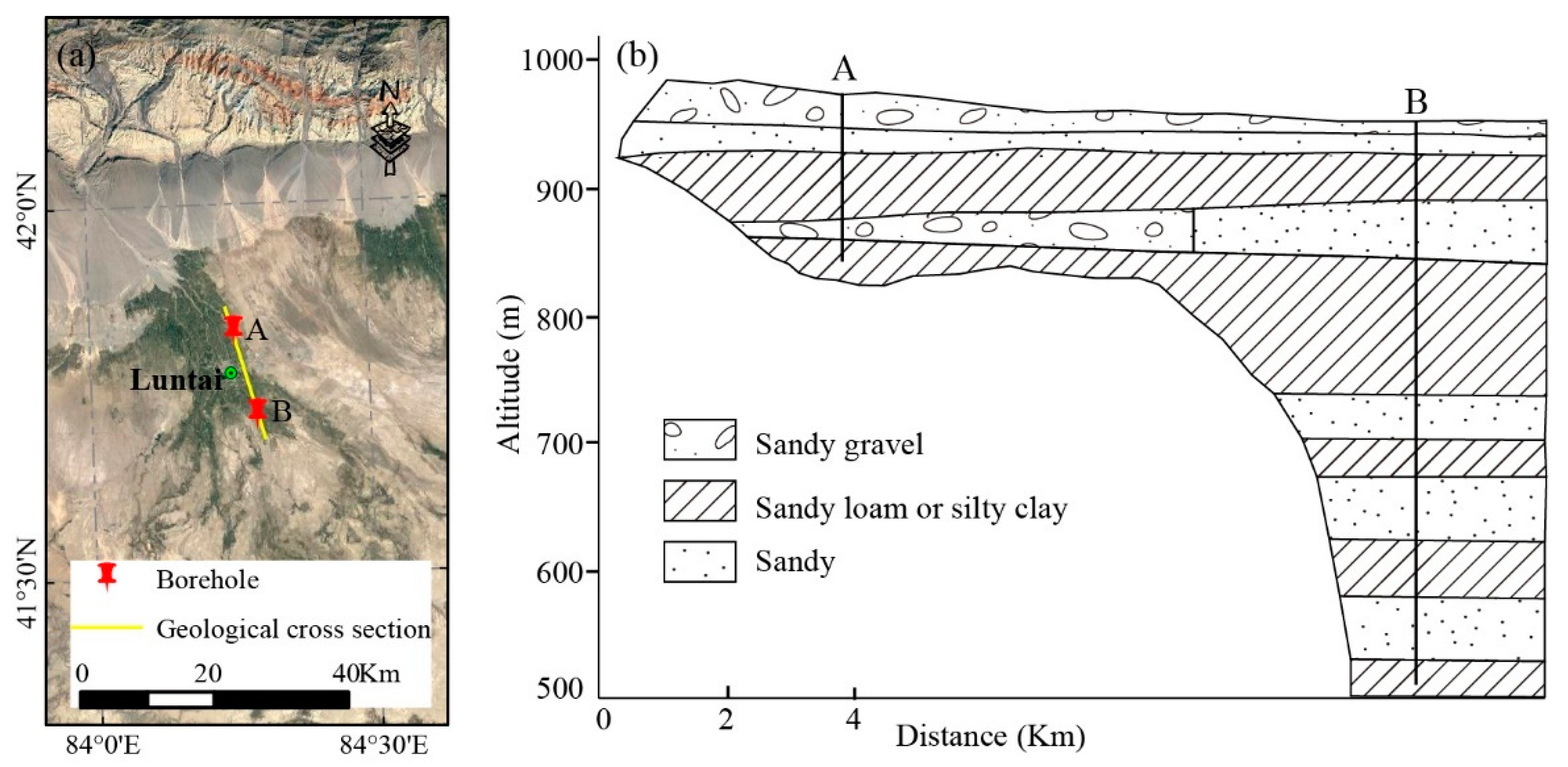





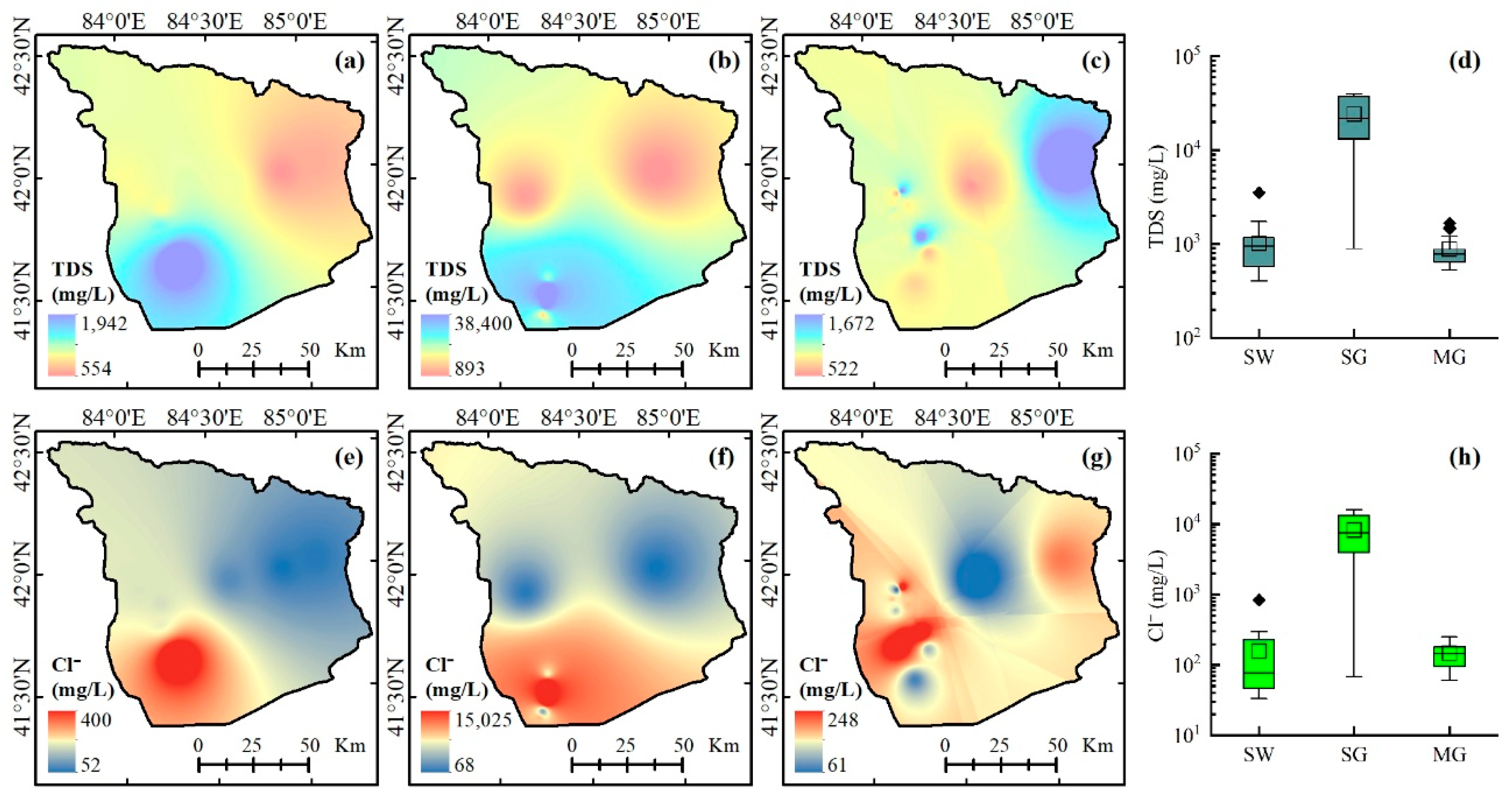
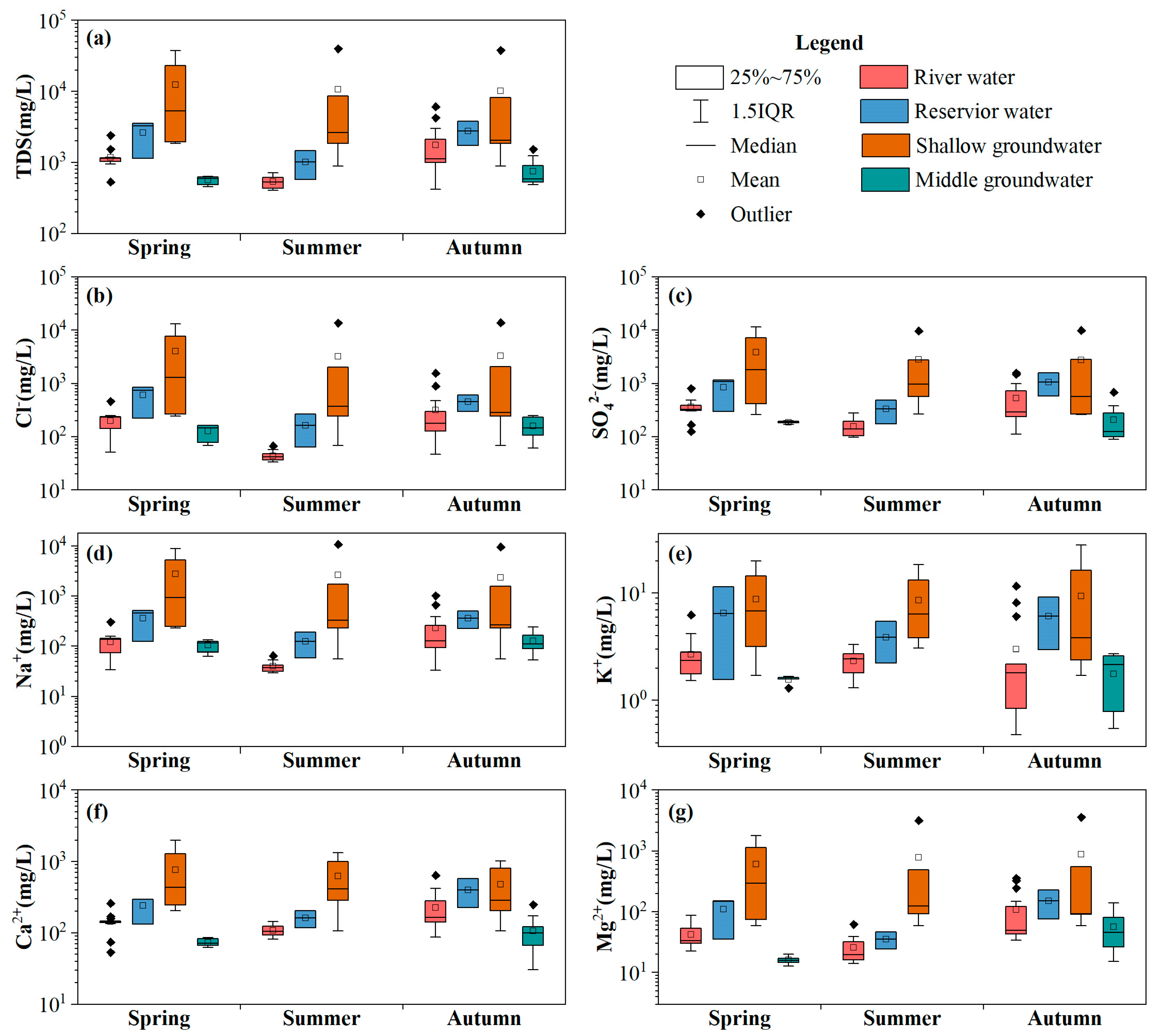
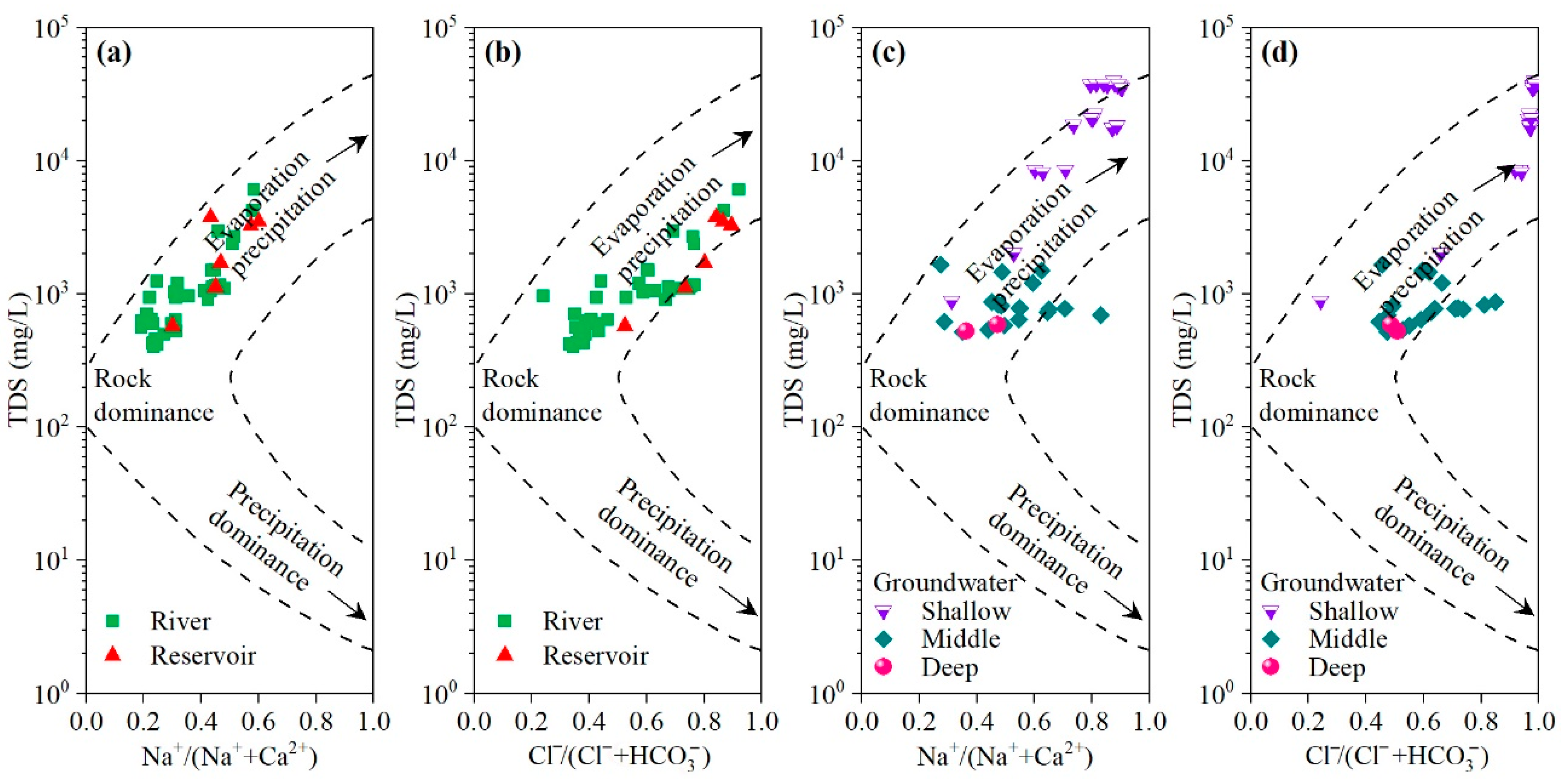
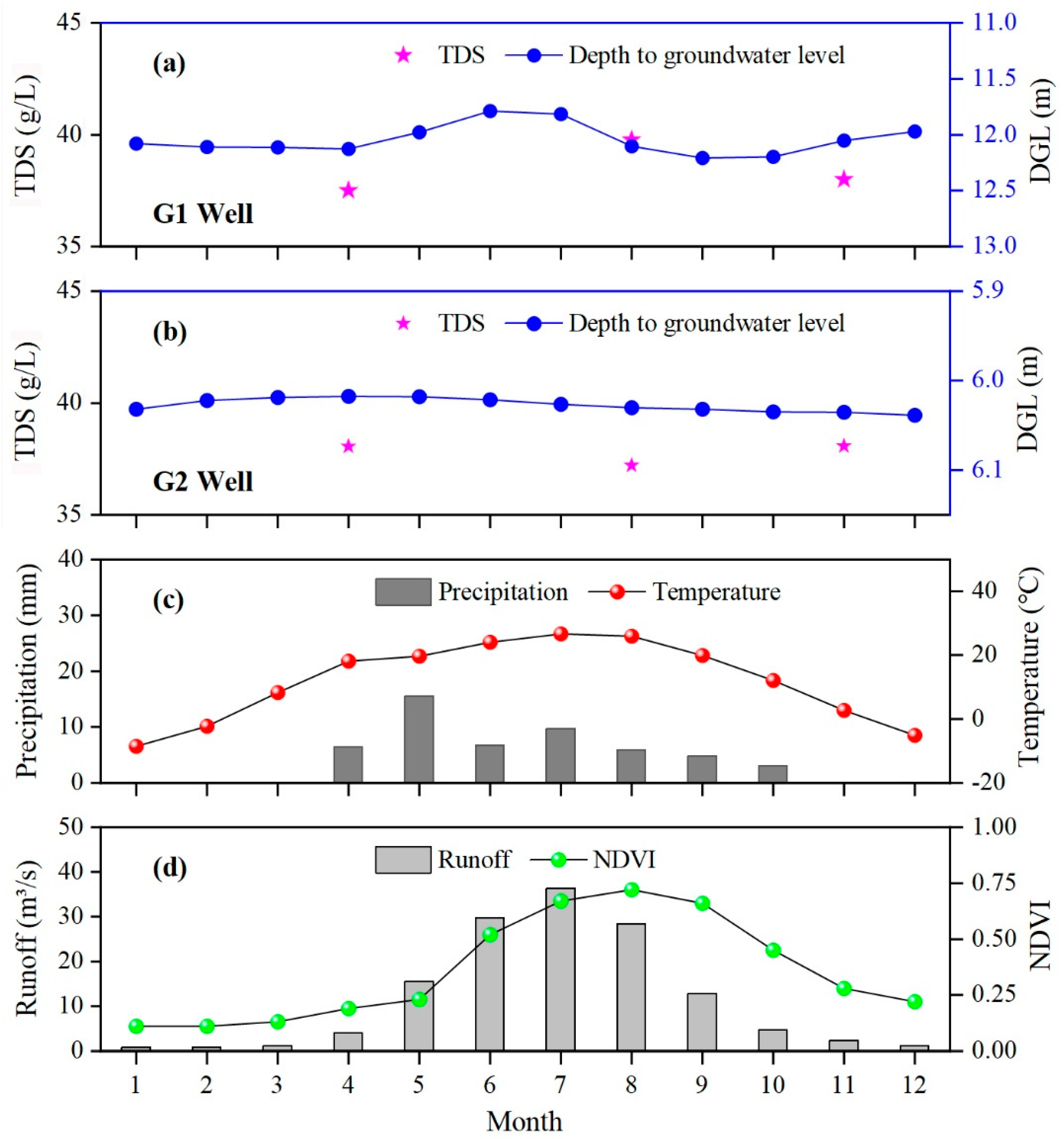
| CL | FL | GL | WL | WB | AS | BL | 2000 | Transfers | ||
| 2000–2010 | CL | 592.03 | 0.00 | 5.80 | 0.02 | 1.42 | 3.48 | 52.47 | 655.22 | 53.99 |
| FL | 0.00 | 0.09 | 0.07 | 0.00 | 0.00 | 0.00 | 0.06 | 0.22 | −0.05 | |
| GL | 3.68 | 0.00 | 1728.52 | 0.22 | 1.04 | 0.02 | 44.73 | 1778.22 | 12.29 | |
| WL | 0.03 | 0.00 | 0.39 | 8.22 | 0.21 | 0.00 | 1.53 | 10.39 | 1.72 | |
| WB | 0.14 | 0.01 | 0.69 | 0.20 | 9.78 | 0.00 | 1.99 | 12.82 | −1.26 | |
| AS | 5.15 | 0.00 | 0.08 | 0.00 | 0.00 | 17.32 | 0.69 | 23.23 | 2.25 | |
| BL | 0.21 | 0.16 | 30.38 | 0.01 | 1.62 | 0.15 | 5250.90 | 5283.43 | −68.95 | |
| 2010 | 601.23 | 0.27 | 1765.93 | 8.67 | 14.07 | 20.98 | 5352.37 | 7763.53 | — | |
| CL | FL | GL | WL | WB | AS | BL | 2010 | Transfers | ||
| 2010–2020 | CL | 617.40 | 0.00 | 509.91 | 0.83 | 1.74 | 5.28 | 198.45 | 1333.61 | 678.39 |
| FL | 0.00 | 0.13 | 1.42 | 0.00 | 0.02 | 0.00 | 0.10 | 1.67 | 1.44 | |
| GL | 16.10 | 0.00 | 1131.39 | 5.02 | 4.94 | 0.03 | 305.40 | 1462.88 | −315.34 | |
| WL | 1.08 | 0.00 | 7.52 | 4.23 | 0.20 | 0.31 | 6.33 | 19.66 | 9.27 | |
| WB | 0.47 | 0.00 | 7.92 | 0.25 | 4.20 | 0.01 | 5.27 | 18.12 | 5.31 | |
| AS | 15.19 | 0.00 | 4.18 | 0.00 | 0.00 | 17.31 | 11.37 | 48.06 | 24.83 | |
| BL | 4.99 | 0.08 | 115.88 | 0.06 | 1.71 | 0.29 | 4756.52 | 4879.53 | −403.90 | |
| 2020 | 655.22 | 0.22 | 1778.22 | 10.39 | 12.82 | 23.23 | 5283.43 | 7763.53 | — | |
| CL | FL | GL | WL | WB | AS | BL | 2000 | Transfers | ||
| 2000–2020 | CL | 569.52 | 0.00 | 507.69 | 0.80 | 3.18 | 6.07 | 246.36 | 1333.61 | 732.38 |
| FL | 0.00 | 0.11 | 1.49 | 0.00 | 0.01 | 0.00 | 0.07 | 1.67 | 1.40 | |
| GL | 8.71 | 0.00 | 1120.54 | 4.87 | 5.10 | 0.01 | 323.63 | 1462.88 | −303.05 | |
| WL | 0.51 | 0.00 | 7.76 | 2.80 | 0.06 | 0.31 | 8.23 | 19.66 | 10.99 | |
| WB | 0.42 | 0.01 | 8.04 | 0.20 | 3.55 | 0.01 | 5.89 | 18.12 | 4.05 | |
| AS | 17.61 | 0.00 | 4.20 | 0.00 | 0.00 | 14.31 | 11.94 | 48.06 | 27.08 | |
| BL | 4.46 | 0.15 | 116.21 | 0.01 | 2.17 | 0.27 | 4756.26 | 4879.53 | −472.85 | |
| 2020 | 601.23 | 0.27 | 1765.93 | 8.67 | 14.07 | 20.98 | 5352.37 | 7763.53 | — | |
| Cl− | SO42− | HCO3− | Na+ | K+ | Mg2+ | Ca2+ | Hydrochemical Type | |
|---|---|---|---|---|---|---|---|---|
| (mg/L) | ||||||||
| River water (n = 20) | ||||||||
| Max | 244.4 | 550.0 | 255.0 | 200.0 | 6.1 | 91.9 | 237.7 | SO4-Ca |
| Min | 33.1 | 98.2 | 108.6 | 29.1 | 0.5 | 14.2 | 74.5 | |
| Mean | 119.9 | 265.9 | 154.6 | 85.0 | 2.3 | 41.9 | 136.3 | |
| Reservoir water (n = 6) | ||||||||
| Max | 840.1 | 1563.2 | 224.7 | 514.7 | 11.5 | 226.5 | 574.2 | SO4-Ca-Na |
| Min | 64.2 | 172.5 | 100.0 | 58.3 | 1.6 | 24.1 | 118.2 | |
| Mean | 461.0 | 808.2 | 156.3 | 314.0 | 5.7 | 110.1 | 274.0 | |
| Shallow groundwater (well depth < 20 m) (n = 21) | ||||||||
| Max | 16016.3 | 11354.2 | 456.3 | 10817.4 | 64.7 | 3619.2 | 1998.1 | Cl-SO4-Na-Mg |
| Min | 68.3 | 260.0 | 224.2 | 55.9 | 0.0 | 90.4 | 107.2 | |
| Mean | 3473.8 | 3093.5 | 330.2 | 2564.5 | 7.6 | 769.6 | 615.9 | |
| Middle groundwater (well depth = 20–100 m) (n = 18) | ||||||||
| Max | 249.0 | 677.4 | 369.9 | 240.4 | 2.7 | 139.4 | 248.8 | SO4-Cl-Na-Ca |
| Min | 60.8 | 89.0 | 76.7 | 53.6 | 0.0 | 12.6 | 30.5 | |
| Mean | 147.3 | 202.1 | 155.9 | 119.7 | 1.6 | 42.8 | 95.9 | |
| Deep groundwater (well depth > 100 m) (n = 2) | ||||||||
| Max | 121.8 | 125.4 | 221.1 | 119.7 | 2.3 | 37.2 | 116.8 | HCO3-Cl-Ca-Na |
| Min | 69.5 | 87.1 | 115.1 | 57.1 | 1 | 34.8 | 87.8 | |
| Mean | 95.6 | 106.3 | 168.1 | 88.4 | 1.6 | 36 | 102.3 | |
Publisher’s Note: MDPI stays neutral with regard to jurisdictional claims in published maps and institutional affiliations. |
© 2022 by the authors. Licensee MDPI, Basel, Switzerland. This article is an open access article distributed under the terms and conditions of the Creative Commons Attribution (CC BY) license (https://creativecommons.org/licenses/by/4.0/).
Share and Cite
Wang, W.; Chen, Y.; Wang, W.; Yang, Y.; Hou, Y.; Zhang, S.; Zhu, Z. Assessing the Influences of Land Use Change on Groundwater Hydrochemistry in an Oasis-Desert Region of Central Asia. Water 2022, 14, 651. https://doi.org/10.3390/w14040651
Wang W, Chen Y, Wang W, Yang Y, Hou Y, Zhang S, Zhu Z. Assessing the Influences of Land Use Change on Groundwater Hydrochemistry in an Oasis-Desert Region of Central Asia. Water. 2022; 14(4):651. https://doi.org/10.3390/w14040651
Chicago/Turabian StyleWang, Wanrui, Yapeng Chen, Weihua Wang, Yuhai Yang, Yifeng Hou, Shuai Zhang, and Ziyang Zhu. 2022. "Assessing the Influences of Land Use Change on Groundwater Hydrochemistry in an Oasis-Desert Region of Central Asia" Water 14, no. 4: 651. https://doi.org/10.3390/w14040651
APA StyleWang, W., Chen, Y., Wang, W., Yang, Y., Hou, Y., Zhang, S., & Zhu, Z. (2022). Assessing the Influences of Land Use Change on Groundwater Hydrochemistry in an Oasis-Desert Region of Central Asia. Water, 14(4), 651. https://doi.org/10.3390/w14040651






